Seven Questions Over Breakfast with Julie Fortenberry
 April 15th, 2014 by jules
April 15th, 2014 by jules


Illustrator Julie Fortenberry is visiting 7-Imp today, and as you can see above, she brought her breakfast along — Cheerios with blueberries and coffee with milk. It looks just right to me (and healthy to boot), and I’m ready to chat with her over coffee.
I should say that Julie, who started her career as an abstract painter, is an author-illustrator, actually. Earlier this month, she saw her writing debut, though previously she’s illustrated others’ books. You can read more below about The Artist and the King, her author-illustrator debut and what Kirkus calls in their review “a nod to art’s twin powers of subversion and of transformation.” It was published by Alazar Press (whom we have to thank for re-printing Ashley Bryan’s compilations of Black American spirituals, but Julie talks about that below too).
 Those of you familiar with the work of Kar-Ben Publishing (a division of Lerner Publishing Group), who publish new children’s books with Jewish content each year, may instantly recognize Julie’s work. As you’ll see below, she’s illustrated many of Jamie Korngold’s stories about a Jewish girl, the cheery and ever-resourceful Sadie.
Those of you familiar with the work of Kar-Ben Publishing (a division of Lerner Publishing Group), who publish new children’s books with Jewish content each year, may instantly recognize Julie’s work. As you’ll see below, she’s illustrated many of Jamie Korngold’s stories about a Jewish girl, the cheery and ever-resourceful Sadie.
Let’s get to it, and I thank Julie for visiting. (I’d like to take this opportunity, by the way, to thank Julie seven-thousand-fold for her blog about children’s book illustrations, which she writes with artist Shelley Davies. Oh, how I’ve enjoyed it over the years.)
(Click to enlarge)
Jules: Are you an illustrator or author/illustrator?
Julie: Author/Illustrator.
Jules: Can you list your books-to-date?

Julie: Illustrator of the following:
- Pippa at the Parade by Karen Roosa, 2009
- Sadie’s Sukkah Breakfast by Jamie Korngold, 2011
- Pirate Boy by Eve Bunting, 2011
- Sadie and the Big Mountain by Jamie Korngold, 2012
- Sadie’s Almost Marvelous Menorah by Jamie Korngold, 2013
- Sadie’s Lag Ba’Omer Mystery by Jamie Korngold, out in 2014
Author/Illustrator of The Artist and the King [April 2014].
Jules: What is your usual medium?
Julie: Photoshop.


Jules: Where are your stompin’ grounds?
Julie: Pittsboro, NC. Population 3,743 (2010 census).
Jules: Can you tell me about your road to publication?
Julie: I started my career as an abstract painter, and I still paint abstractions from time to time. I was once in a Whitney Museum exhibit with Carroll Dunham (Lena’s dad) and the Starn Twins. That was a lifetime ago.

(Click to enlarge)
As an illustrator, I’m self-taught. I started tinkering with Adobe software that a friend gave me not long after I had children. It was satisfying to be creative in a way that was accessible to my kids. In 2006, the High Five magazine and Boyds Mills Press editors found my illustration portfolio on childrensillustrators.com. The art directors and editors of Honesdale, PA, gave me my first assignments.
(Click to enlarge)
(Click to enlarge)

Jules: Can you please point readers to your web site and/or blog?
Julie: www.juliefortenberry.com.
My abstract work can be seen here.
Artist Shelley Davies and I blog about children’s illustration here. (Shelley finds the best stuff.) We recently started a Facebook page, too: www.facebook.com/childrens.illustration.9


Jules: Any new titles/projects you might be working on now that you can tell me about?
Julie: I have a new Sadie book coming out in September (Sadie, Ori, and Nuggles Go to Camp) and one more Sadie book in the pipeline. I’m also writing and illustrating an easy reader.

 Okay, I’ve got more coffee, and it’s time to get a bit more detailed with seven questions over breakfast. I thank Julie again for visiting 7-Imp.
Okay, I’ve got more coffee, and it’s time to get a bit more detailed with seven questions over breakfast. I thank Julie again for visiting 7-Imp.
1. Jules: What exactly is your process when you are illustrating a book? You can start wherever you’d like when answering: getting initial ideas, starting to illustrate, or even what it’s like under deadline, etc. Do you outline a great deal of the book before you illustrate or just let your muse lead you on and see where you end up?
Julie: My process varies, depending on the editor. Some editors send layouts with the words in place and detailed instructions; others leave the layout up to me. For Eve Bunting’s Pirate Boy, I was free to create the page turns, to choose what to illustrate, and even to choose the dimensions of the book. I hand-drew little story boards to figure out how to pace the pictures. The sketches and final illustrations were done with Photoshop (using a mouse).
As for The Artist and the King, the project started when my husband recounted a tale about WWII. The Danes, he said, had made Nazi orders unenforceable when they all opted to wear the yellow star. Really this is a myth, but I wished it were true. That idea of people working together to undermine a tyrant became the seed for The Artist and the King, and the yellow star became a dunce cap.
Of course, because I was writing for children, everything else changed too. My friend, the writer Kathleen O’Dell, helped me with the first couple of drafts (and by “couple,” I mean twenty). Almost from the start, the illustrating and writing happened simultaneously. The pictures sparked the words and vice versa. In fact, the entire road to publication was intertwined with the writing and rewriting process. I submitted a dummy of the story (by emailing a link to a web slideshow) to several editors and received feedback. One editor in particular outlined ways for improving the story. Still, after revisions, she wasn’t quite ready to commit to it.
feathers and buttons to make new caps.”
(Click to enlarge)


(Click to enlarge)


(Click to enlarge)
(Alazar Press, 2014).
Around this time I moved to North Carolina, and I saw Ashley Bryan’s work at the North Carolina Museum of Art. His beautifully illustrated compilations of Black American spirituals (Walk Together Children and I’m Going to Sing) were republished by Alazar Press, just up the road from me. I queried the founder of Alazar, Rosemarie Gulla, about the project. Rosemarie loved the story and agreed to publish it. The final edit was done by the wonderful writer and editor Jacqueline Ogburn. And the book designer, Julie Allred, adjusted the layout in a way that improved the flow of the story.
With so much help, it was a little like making stone soup. But in this version of Stone Soup, the villagers are extremely talented and generous.


2. Jules: Describe your studio or usual work space.
Julie: Big. One of the perks of living in a small southern town is that I can afford work space. My husband and I use the top floor of our home as a studio. His side is for painting and collage. It’s full of paint, glue, and bits of ripped up Life magazines. If I want a watercolor backdrop to scan into my work, I can find it over there.
(Click to enlarge)

3. Jules: As a book-lover, it interests me: What books or authors and/or illustrators influenced you as an early reader?
Julie: The first book I read alone was The B Book by Phyllis McGinley, illustrated by Robert Jones. I loved Marcia Brown’s Stone Soup (read by Captain Kangaroo) and my Little Golden Book Picture Dictionary illustrated by Tibor Gergely.
And then there’s The Five Chinese Brothers by Claire Huchet Bishop and Kurt Wiese. I remembered the picture of the ocean being swallowed by the one brother and his struggle not to spit it out, because when he does spit it out, a little boy will drown — and that’s just the first brother. There are four more brothers and four methods of execution, one involving suffocation by burning whipped cream. I think it’s safe to say that they don’t write ‘em like that anymore.

4. Jules: If you could have three (living) authors or illustrators—whom you have not yet met—over for coffee or a glass of rich, red wine, whom would you choose? (Some people cheat and list deceased authors/illustrators. I won’t tell.)
Julie: Lynda Barry, David Small, and Shirley Hughes.
by Jamie Korngold (Kar-Ben, 2011)
(Click second image to enlarge)
5. Jules: What is currently in rotation on your iPod or loaded in your CD player? Do you listen to music while you create books?
Julie: Amy Winehouse, Kid Creole and the Coconuts, Lily Allen, Nellie McKay, The Kinks, Madeleine Peyroux, Sly and the Family Stone.
I listen to music when the reading/math part is over, yes.
6. Jules: What’s one thing that most people don’t know about you?
Julie: I’m a good dancer. Please, someone invite me to a wedding reception.
Sadie’s Lag Ba’Omer Mystery (Kar-Ben, January 2014)
(Click to enlarge)
7. Jules: Is there something you wish interviewers would ask you — but never do? Feel free to ask and respond here.
Julie: Who is your favorite writer for adults?
Anne Tyler. A review by Tara Gallagher accurately described Anne Tyler as a “master of the fine threads of human relationships.” I love movies about the fine threads, too. Mike Leigh’s Another Year is a favorite.

Sadie’s Almost Marvelous Menorah (Kar-Ben, 2013)

Jules: What is your favorite word?
Julie: “Shoehorn.” It cracked me up the first time I heard it, and it still cracks me up.
“Flummoxed” is another good word.
Jules: What is your least favorite word?
Julie: “Yummy.”
Jules: What turns you on creatively, spiritually or emotionally?
Julie: A liberal arts education — what Sarah Vowell calls “that trap door to a bottomless pit of beauty.”
Jules: What turns you off?
Julie: Bean-counting.
7-Imp: What is your favorite curse word? (optional)
Julie: Every word Susie Essman’s character, Susie Greene, has ever yelled. She has a talent for alliteration.
Jules: What sound or noise do you love?
Julie: The wail of loons on a lake. The voices of my family playing board games as I fall asleep on the couch.
Jules: What sound or noise do you hate?
Julie: Eric Cantor’s voice.
Jules: What profession other than your own would you like to attempt?
Julie: Acting.
Jules: What profession would you not like to do?
Julie: Anything where I’d have to pronounce French words in front of people, like waitressing at the Lord Jeffery Inn. Just ask my friend Jennifer Thermes about my pronunciation of the word giclée.
Jules: If Heaven exists, what would you like to hear God say when you arrive at the Pearly Gates?
Julie: “It’s okay.” And then I’d like to hear Bobby Darin sing “Beyond The Sea.”

All artwork and images are used with permission of Julie Fortenberry.
The spiffy and slightly sinister gentleman introducing the Pivot Questionnaire is Alfred, © 2009 Matt Phelan.



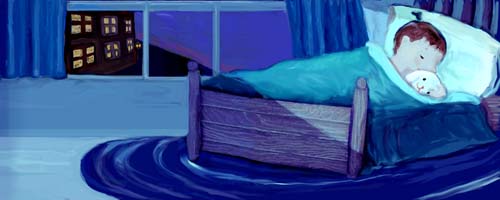

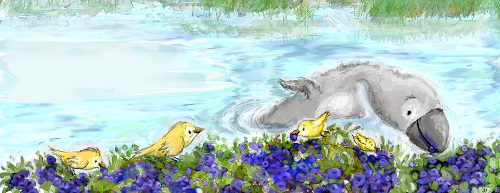










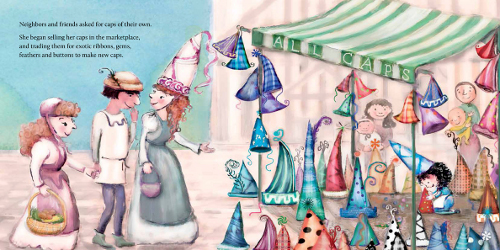


 in the studiosmall.jpg)
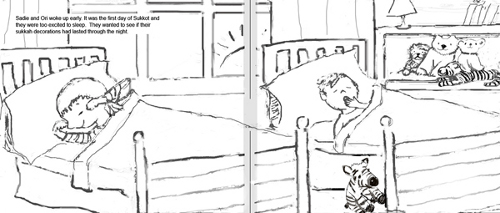




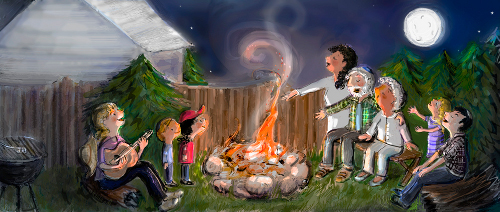

What colorful, happy illustrations! Thanks so much for sharing them!
What a lovely studio! (And oh, how I wish I could get my hands on a bootleg Eric Cantor karaoke session for your birthday!)
Kathy: HA. You just won Best Comment!